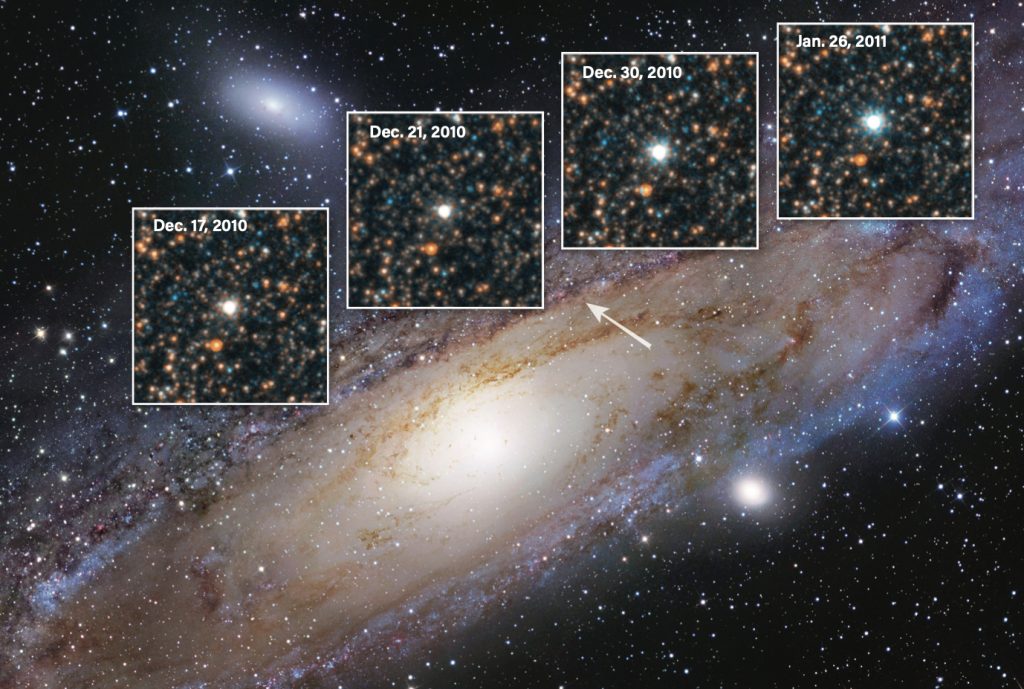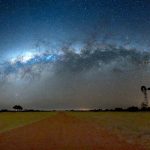Cepheid variable stars enable astronomers to measure distances, and Hubble identified one such star within the M31 ‘spiral nebula.’
Key Takeaways:
- Cepheid stars exhibit predictable variations in brightness that correspond to their pulsation periods.
- Astronomers can determine a Cepheid star’s distance using the relationship between its pulsation period and intrinsic brightness.
- Hubble identified a Cepheid variable in the Andromeda Nebula and used its pulsation period and intrinsic brightness to determine its distance.
- The measured distance placed Andromeda far beyond the Milky Way, confirming that it is an independent galaxy.
In what way did a Cepheid variable star enable Edwin Hubble to demonstrate that the Andromeda Nebula is a separate galaxy?
Roger Brady
San Quentin, California
Cepheids are rare variable stars with pulsation periods ranging from roughly 1 to 120 days. Their light curves, which plot brightness over time, show a rapid increase followed by a gradual decrease in luminosity, creating a distinctive and recognizable pattern. In the early 20th century, Henrietta Swan Leavitt of Harvard College Observatory analyzed photographic plates of the Magellanic Clouds and identified 1,777 new variable stars, including several Cepheids. Her key discovery was that a Cepheid’s luminosity at maximum brightness correlates with its period: the longer the period, the brighter the star.
Leavitt reasoned that because the Cepheids she studied were all located within a single deep-sky object—the Magellanic Clouds—they must lie at roughly the same distance from Earth. Consequently, their apparent magnitudes, which measure brightness as seen from Earth, provided reliable indicators of their intrinsic luminosities. In 1912, she published a seminal graph based on 25 Cepheids in the Small Magellanic Cloud, revealing a linear relationship between the logarithm of their periods (in days) and their average apparent magnitudes. This discovery, now known as the period-luminosity relationship or Leavitt law, remains one of the foundational principles of astrophysics.
Danish astronomer Ejnar Hertzsprung recognized the profound significance of Leavitt’s work. By determining the distance to any Cepheid, one could combine that information with its apparent magnitude to calculate its absolute magnitude, thereby calibrating Leavitt’s period-luminosity graph in terms of intrinsic brightness rather than observed brightness. This breakthrough meant that the distance to any Cepheid could thereafter be derived using only its period and apparent magnitude. Hertzsprung applied statistical parallax—a method that uses Earth’s motion around the Sun to measure a star’s shift relative to more distant background stars—to calculate distances to 13 Cepheids, including the prototype δ Cephei, and used these results to calibrate Leavitt’s graph with absolute magnitudes.
When Edwin Hubble identified a Cepheid in the so-called Andromeda Nebula, he recognized a unique opportunity to determine its distance. Using a series of photographic plates, he measured the star’s period at 31.415 days and its average apparent magnitude at 18.5. By referencing a calibrated period-luminosity graph, he determined that a Cepheid with this period has an absolute magnitude of –5.0. For a star of –5.0 absolute magnitude to appear at 18.5, it would need to be at an immense distance—well beyond the Milky Way as measured by Harlow Shapley—demonstrating that Andromeda must be an independent galaxy.
For a detailed account, see my article in the August 2022 issue of Astronomy, where I recreated Hubble’s observations using my backyard telescope and CCD camera, successfully reproducing his results.
Rod Pommier
Astroimager and Astronomy contributor, Portland, Oregon



